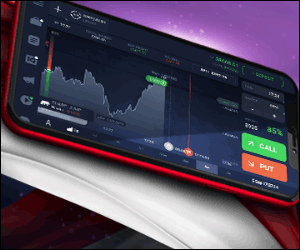What Are Binary Option And How Do They Work
Binary options have emerged as a simple yet powerful financial instrument for traders seeking fixed-risk, fixed-reward trades. Whether you're new to online trading or a seasoned investor diversifying your strategy, understanding the mechanics of binary options is essential to leveraging their potential effectively.
Pocket Option Trading broker Link
VIP Signal Free Telegram
The word "binary" refers to the two possible outcomes: a trader either makes a fixed profit or incurs a fixed loss.
A binary option does not grant ownership of the asset. Instead, it offers a prediction mechanism—will the asset’s price go up or down within a set time frame?
How Do Binary Options Work?
-
Will the price of an asset be above a certain level at a specific time?
Here's how a typical trade works:
-
Choose an asset (e.g., stocks, currencies, commodities, indices).
-
Select an expiry time (ranges from 60 seconds to several days).
-
Predict the direction of the price movement (call if you expect it to rise, put if you expect it to fall).
-
Place your trade.
-
At expiry, the trade closes automatically. If your prediction was correct, you receive a fixed return (usually 60%–90%). If incorrect, you lose your investment.
Key Components of Binary Options
1. Underlying Assets
-
Forex (e.g., EUR/USD, GBP/JPY)
-
Stocks (e.g., Apple, Tesla)
-
Commodities (e.g., Gold, Oil)
-
Indices (e.g., S&P 500, FTSE 100)
2. Strike Price
This is the predetermined price at which the trader predicts the asset’s value will be above or below at expiry.
3. Expiry Time
Expiry times can vary dramatically:
-
Ultra short-term (30 seconds to 5 minutes)
-
Short-term (15 minutes to 1 hour)
-
Medium to long-term (several hours to weeks)
4. Payout and Loss
Payouts are fixed returns (often 70% to 90%) on successful trades. Conversely, losses are also fixed—you lose the invested amount if the trade goes against your prediction.
Types of Binary Options
1. High/Low (Call/Put) Options
The most common type. You predict whether the asset’s price will be higher or lower than the strike price at expiration.
2. One Touch Options
You predict whether the asset price will touch a predetermined price level at least once before expiry.
3. No Touch Options
The opposite of One Touch. You win if the asset price does not touch a certain level before expiry.
4. Range or Boundary Options
You predict whether the asset price will stay within a specified range until expiry.
Binary Options vs Traditional Options
| Feature | Binary Options | Traditional Options |
|---|---|---|
| Ownership of Asset | No | Possible |
| Payout Structure | Fixed return or fixed loss | Variable based on price movement |
| Complexity | Simple (yes/no decision) | Complex (many factors to consider) |
| Risk | Fixed and known in advance | Variable, dependent on market movement |
| Expiry Time | Short to medium | Can range from days to months |
Regulations and Legitimacy
While binary options are legal in many jurisdictions, they are also highly regulated or banned in others due to scam risks and fraudulent brokers. In the United States, binary options are regulated by the Commodity Futures Trading Commission (CFTC). Only designated exchanges like NADEX are allowed to offer them.
In the European Union, the European Securities and Markets Authority (ESMA) has imposed a ban on binary options for retail investors due to high risk.
Always ensure the platform is licensed and regulated before trading.
Choosing a Reliable Binary Options Broker
When selecting a platform, consider:
-
Regulation and licensing
-
Transparency of payouts
-
Ease of withdrawal
-
Customer service availability
-
Educational resources
-
Demo account for practice
Recommended brokers often include platforms like IQ Option, Pocket Option, and NADEX (for U.S. residents).
Strategies for Trading Binary Options Successfully
1. Trend Following
Identify the direction of the market trend and place trades in the same direction. Use indicators like moving averages or Bollinger Bands.
2. News-Based Trading
Market news—like interest rate announcements or earnings reports—can influence asset prices. Reacting quickly to news can help traders capitalize on short-term volatility.
3. Risk Management
Only invest a small percentage (e.g., 1%–5%) of your capital per trade. Avoid emotional trading, and use stop-loss techniques to limit downside risk.
4. Time Frame Matching
Align your analysis time frame with your chosen expiry. For example, if you're using a 5-minute chart, use short-term expiries like 5 to 15 minutes.
Advantages of Binary Options
-
Simplicity: Easy to understand, even for beginners.
-
Quick Returns: Short expiry times allow fast decision-making.
-
Fixed Risk: Know your potential loss upfront.
-
Accessibility: Tradeable 24/7 on many platforms.
Risks and Drawbacks
-
High Risk of Loss: 70%–90% of retail traders lose money.
-
Potential for Fraud: Many unregulated brokers operate scams.
-
Limited Profit Potential: Returns are capped, unlike traditional trading.
-
Addictive Nature: The fast-paced environment can lead to impulsive trading.
Are Binary Options Right for You?
Binary options can be attractive to traders who:
-
Prefer short-term trading
-
Want clearly defined risk and reward
-
Can make fast, disciplined decisions
-
Use proper money management techniques
However, they are not suitable for those looking for long-term investing, low-risk returns, or passive income.
Final Thoughts
Binary options offer a high-risk, high-reward trading method with clearly defined outcomes. When used responsibly, and through regulated brokers, they can serve as a powerful tool in your trading arsenal. However, understanding the intricacies, risks, and regulatory environment is critical before diving in.

.jpg)
.jpg)


0 Comments